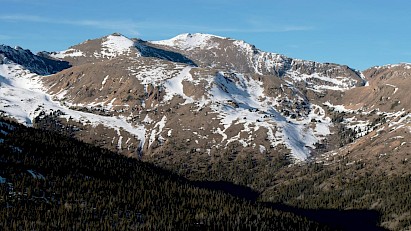The western U.S. might be seeing its last snowy winters
 When a fire started spreading quickly in Boulder County, Colorado, on December 30, destroying nearly 1,000 homes as residents fled, the ground was dry. This was unusual: Boulder typically gets around 30 inches of snow between September and December. But last year, it had only a total of 1.7 inches over the same period before heavier snow finally started falling on December 31—too late to save the neighborhoods that burned.
When a fire started spreading quickly in Boulder County, Colorado, on December 30, destroying nearly 1,000 homes as residents fled, the ground was dry. This was unusual: Boulder typically gets around 30 inches of snow between September and December. But last year, it had only a total of 1.7 inches over the same period before heavier snow finally started falling on December 31—too late to save the neighborhoods that burned.
It’s a pattern that’s becoming more common because of climate change. Nearby, Denver didn’t get any snow until December 10, the latest date since record keeping began in 1882. It was so warm in Colorado that ski resorts often couldn’t even make fake snow. In California, though heavy snow fell in the Sierra Nevada mountains in December, recent winters have seen extreme drought: Last April, when the snowpack in the Sierras should have been at its highest point, it was at just 4% of the average.
One recent study from Lawrence Berkeley National Laboratory researchers projects that if climate change continues on its current path, by the late 2040s the Sierras could see “low to no snow” events with little or no snowpack on mountains for five-year stretches. By the late 2050s, periods with little or no snow in the area could last a decade or more. That’s likely in the Pacific Northwest by the 2060s, and in upper Colorado by the following decade. The snowpack in the Western U.S. is already 20% less than it was in the 1950s, a volume of water that could fill Lake Mead, the largest reservoir in the country.
“Climate change is impacting our snowpack in a couple of different ways,” says Keith Musselman, a researcher at the University of Colorado-Boulder who studies the impacts of climate change on water availability. “As temperatures warm, we’re seeing a shift from snowfall to rain. And that’s happening at lower elevations, where the majority of people live.” Warmer temperatures also mean that the snow that does fall melts more quickly. There’s less snow in the winter, and even less in the “shoulder” seasons of fall and spring, so the whole snow season is shorter.
Boulder County is also experiencing drought, but if there had been snow on the ground, the fire wouldn’t have spread as quickly. “In the absence of snow cover or frequent rainfall, things are dry, they’re parched, and the flammability of the landscape is higher,” Musselman says. High winds are common in the area in late December, and the wind made the recent fire more destructive. But if the ground hadn’t been so dry from warm temperatures and drought, a spark wouldn’t have led to such a catastrophe.
The lack of snow is also a major problem for water supplies. The Colorado River, which brings water to 40 million people in cities as far away as Los Angeles, is fed by melting snow—and it’s shrinking. Snowpack in the Sierras provides around a third of the water used in cities and on farms in California. Even when snow falls, if the ground is dry and temperatures are warmer than usual, the melting snow isn’t making it to reservoirs. The lack of snow also impacts rainfall, since storms traveling over snow-covered mountains often pick up moisture that gets carried to other areas.
By the end of the century, most years could be nearly snowless in the Western U.S., the Lawrence Berkeley National Lab study suggests. The researchers say that Western states should be taking action to adapt now. For example, during wet years, extra water could be “banked” in reservoirs and aquifers to help make up for the loss of snowpack. Better forecasting could help reservoir operators choose the best times to hold or release water.
Limiting climate change is also crucial, since each fraction of a degree of warming is leading to less snow. Musselman says that anyone who’s concerned about snow loss—and other impacts from climate change—should be pressuring their elected officials to take climate action. “Emphasize the seriousness of it for you, and then bring it into your personal narrative,” he says. “How is it affecting you? What is your concern? Is it for your family? If you’re a rancher or a farmer, is it for your livelihood? Communicate that narrative.”
You can return to the main Market News page, or press the Back button on your browser.

